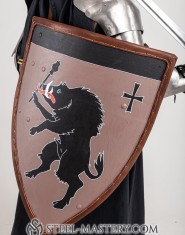Acerca de Escudos
Shields
Shields
Reseña de artículos
This is my second shield from Steel Mastery. The first one was perfect and this one is perfect. Incredible workmanship. I'm highly satisfied. I highly recommend any shield from SM.
It's gorgeous. Leather edge, custom painting, leather handle, size, material, it all fits just what I desired. Adam says it all. It made its way here well wrapped, very safe from damage. Not sure how to say it, but it feels good to hold and use
